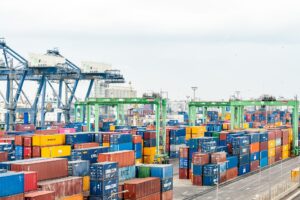Insurance Solutions
Cargo Insurance
Shipping goods around the world has never faced bigger risk management challenges. Our Cargo & Logistics specialists are leaders in the field, helping you and your business avoid business disruptions and recover from ever-present perils.
Coverage:
- Motor truck cargo
- Carrier’s legal liability
- Primary stock
- Stock throughput
- Strikes expenses
- Deterioration of perishable goods
- Excess stock
- Terrorism and political risks
- Trade disruption
- Global transit risks
- Warehouseman’s legal liability
- Governmental rejection
- War and strikes risk
Resource Library
Long-haul truckers face extreme health risks due to their lifestyle, but there are things that can help. Healthier truckers mean fewer claims and safer roads for everyone. One solution is for trucking companies to coordinate with insurance carriers to provide wellness benefits tailored to truckers’ unique needs.
Key takeaways:
Most drivers are paid only when driving. | Loading, unloading, inspections and other tasks are necessary parts of a truckers job – however, most drivers don’t get paid for their time while these activities are taking place. To make a profit, they are increasingly pushed to take long-haul contracts, which increase health risks.
Truckers often face health risks without insurance. | One statistic notes a drastic reduction in life expectancy — 16 years! — for truckers due to health conditions exacerbated by their occupation. While a few large retailers offer generous benefits, most drivers lack adequate coverage to manage their health.
Truck stop wellness programs could be one answer. | Can you imagine truck stop wellness centers with yoga classes and nutritional coaches? If employers and insurance carriers worked together to provide preventative health and wellness care in ways that are accessible to drivers, it would lead to healthier truckers and safer roads for everyone.
CSEG is an automotive software and engineering consulting company. Co-founder Sudhi Uppuluri conceived of his Tech DeepDive interview series as a way to make deep technical details of emerging technologies accessible to the layperson. Risk Cooperative’s Les Williams’ background in mechanical engineering and risk management provides an intersection for nuanced conversations about the rapidly changing world of mobility.
Are autonomous vehicles more safe or less safe than human drivers?
Many people equate risk with negative outcomes, however one can liken it to calling a play in football. Coaches make calculated risks based on data – and tolerating certain risks can lead to big wins.
In the insurance world, when it comes to calculating risk, factors such as industry, annual revenue and past claims can affect the risk rating for insurance. Insurance markets have many years of past data to help understand and quantify these risks.
The challenge with autonomous vehicles, is that performance data is still being developed. Despite claims to the contrary, self-driving cars currently have a higher rate of accidents than human-driven cars, but the injuries are less severe. On average, there are 9.1 self-driving car accidents per million miles driven, while the same rate is 4.1 crashes per million miles for regular vehicles. What is more certain is that we should expect to see insurance premiums start to come down as autonomous vehicles become more widely used and more data that is collected.
Who’s to blame in an accident involving an autonomous vehicle?
The concept of vicarious liability may apply to these cases, meaning that there could be multiple parties held to account. In hospitals a malpractice suit may name the hospital, the equipment manufacturer and the physician. As AI and big data take up more space in medical decision-making, doctors are cautioned not to overly rely on these technologies as such dependence could lead to dangerous errors. Similarly, balance between human beings and autonomous vehicles is needed to counteract the potential for mistakes on either side. Still, there are likely to be multiple parties held responsible when things go wrong.
What about data privacy concerns?
As autonomous vehicles gain further traction, the data collected will trigger a tug of war between consumers and vehicle manufacturers, says Les. Again, there are lessons In the healthcare space, where your health related data (stripped of personal identifiers) can be used, without explicit permission, to advance medical science. A case could be made that consumer data from autonomous vehicles should be used in a similar fashion, without permission, to address safety issues. Like other Big Tech issues, navigating regulatory concerns should be the job of federal governments. Even in places with strict data privacy laws in place, such as GDPR in the EU, the regulatory bodies my see fit to create exceptions regarding autonomous car data usage for the purposes of greater safety.
How comfortable are you with wireless vehicle software updates?
With the world of connected devices growing to 25 billion by 2030, there are massive exposures for both cyber attacks and critical software system failures. Not only that, but a software bug that is automatically uploaded could prove catastrophic.
In a threat landscape where hackers are relentlessly keeping pace with every new cybersecurity development, civilian infrastructure targets are at particularly high risk. Rather than over-the-air updates, a safer solution for passenger vehicles would be to have software updated as a routine maintenance service, where these service stations can be maintained at the highest levels of cybersecurity.
While e-bikes and scooters are great for sustainability, how risky are they?
E-bikes and scooters may be a market threat for electric cars as they help people navigate urban areas efficiently – and cities are embracing the sustainability trend with bike lanes and traffic calming measures – but the lack of safety regulations and equipment (like helmets) creates significant personal risk.
Federal regulation could create uniformity across state lines, with speed and safety enforcement by officers or even by unmanned sensors. Additionally, to control insurance costs, taxes levied on companies and users could contribute to an accident fund to help injured parties, using a model similar to the “wildfire fund” being implemented in California.
We have to talk about cyber. How important is cybersecurity awareness?
Frankly, while Risk Cooperative works across the full spectrum of risk, cyber risk is 110% of our mindshare. The proliferation of cyber threats from ransomware to deep fakes means that cyber insurance coverage has become important for all clients, regardless of contract requirements or business size. Our job as risk experts is to make clients aware of cyber risk as well as the insurance solutions available to mitigate that risk.
Any final tips for organizations, product designers, and individuals?
“Company leaders need to know that cybersecurity is no longer just an IT imperative, it’s a business imperative. Understand that your CISO is an instrumental part of your business resiliency,” says Les, “and your board needs at least one seat reserved for someone with cybersecurity experience.”
When creating new connected products, designers need to assume their products will be hacked. With that in mind, they need to make clear recommendations for good cyber hygiene protocols that consumers can put in place to protect themselves.
For individuals, data backups are critical in the event that your cloud storage is compromised; one easy step toward greater cybersecurity is to make sure your important data is backed up frequently an external drive.
VIEW THE RECORDING:
Autonomous Vehicle Cybersecurity & Risk: Les Williams with Sudhi Uppuluri
CYBER 101 RESOURCE LIBRARY:
Cyber Insurance Coverage Overview
Minimum Cybersecurity Checklist
Sample Technical Specifications
Have questions? Send us a message.
Images of a mega tanker Ever Given blocking the Suez Canal, an artery for 10% of the world’s trade, is an emblem of the world’s evolving supply chain challenges. Indeed, 2020 with the paralysis caused by the COVID-19 pandemic, along with the nationalistic instincts to erect borders and introduce global fractions to trade, commerce, and travel, is only the latest punctuation mark showing how brittle the world’s supply chains really are. The forces of supply and demand together with business rationalization of costs, has stretched the limits of globalization and just-in-time approaches so thin, that the world’s supply chains resemble a Stradivarius violin—they are priceless, fragile, and tightly strung.
Some of the insidious ways this tenuous supply chain has shown strain, includes the fact that for many so-called fortress nations around the world, the production and inventory of comparatively basic supplies was meager. From N95 masks to simple ventilators and life-saving personal protective equipment (PPE), among other essential material to combat the pandemic, the reliance on far-flung production and continuous shipping and air transport routes showed the risks of off shoring.
In the run up of globalization over the last 50 years, the pendulum swung too far afield. As supply chains and foreign direct investment grew around the world, accelerated in the year 2000 by the moniker BRICS—which directed business activity and a fierce investment race to Brazil, Russia, India, and China (along with other emerging economies)—supply chain linkages were stretched even further. Today, the tendency is to skew to ultra-national interests. From blocking or seizing COVID-19 vaccine exports, referred to as vaccine nationalism, to using war powers for directing companies to manufacture essential materials, it would seem the pandemic combined with other political tendencies are beginning to change the nature of global integration, which will have profound implications on supply chain management. Just as the post-2008 financial crisis world was informed by the lesson “cash is king,” speaking to how chastened corporate treasurers realized the limitations of leverage, so too supply chain leaders have realized the limitations of just-in-time, priceless, and tightly strung supply chain linkages. If cash is king, is on-shore or near-shore the kingdom?
While COVID-19 is certainly the global supply chain antagonist of 2020, it is not the only adverse force showing how brittle the world’s supply chains really are. 2020 was another year roiled by record climate change effects that paralyzed many communities, countries, and global supply chains. An emblem of this is the fact that the first ocean going vessel was able to traverse the Arctic in the winter, showing the prospects of an open ocean sea route in the North Atlantic. While this may be heralded by some as a potential global supply chain advantage, the invariable long-term effects on global coastal communities, along with the accelerating rate of climate change impacts, will negate any gains from a widening berth across once untraversable ice. Indeed, what is transpiring at a global level is also manifestly posing supply chain challenges in a hyper-local environment as well. Here too, preserving cold temperatures matters, as the world’s ability to sound the “all clear” on COVID-19 hinges on our ability to get safe vaccines to the world’s population, which in turn hinges on an incredibly unreliable and unequal cold supply chain.
The other megatrend affecting supply chains is the dueling risks and rewards of cyber threats and digital transformation, in which the rate of connecting everything to the internet continues unchecked. Historically, a proverbial “air gap” between critical infrastructure or relationships was the overarching goal with supply chain management and business continuity planning, especially in the military context, from which the discipline is born. When the internet of things (IoT) creates an unknown backdoor to critical infrastructure, meat processing plants, industrial and farming equipment, the true peril is laid bare. Recent examples show how this exposure via internet-connected devices, sensors and the ever-present danger between the keyboard and the chair (low human cyber hygiene) are complicating basic modern economy activities such as keeping the lights on or gas stations running. The world is in a perennial game of cyber risk whack-a-mole and supply chains are in the crosshairs.
In a global economy that is equal parts haves and have nots, always on and digital, versus partially on and analog, supply chain and business continuity is not only about the reliability of transporting goods around the world, but also about the hyper-local reality of being able to keep the lights on. You can have electricity and no economic growth, but you cannot have economic growth without reliable, low-cost electricity. Here too, the veritable supply chain of electrons is being roiled by a turbulent risk landscape, where the single source of failure infrastructure designed in the 1940s and 50s, built in the 60s and 70s, is looking very feeble in the face of 21st century risks. Shoring up supply chain resilience post-pandemic, will require not only a rethink and recalibration of the limits of globalization, but it will also require strengthening the deeply strained chain of global resilience (and reengagement) one link at a time.




